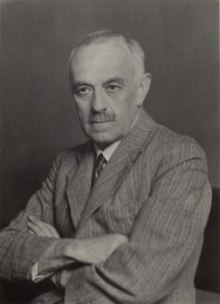
Wilfred Eade Agar (27 April 1882 – 14 July 1951) was an Anglo-Australian zoologist.
Agar was born in Wimbledon, England. He was educated at Sedbergh School, Yorkshire, and at King's College, Cambridge, where he read zoology. He served at Gallipoli in World War I.
In 1919, he accepted the chair of zoology at the University of Melbourne; his notable projects concerned marsupial chromosomes and inheritance in cattle. He successfully challenged the Lamarckian findings of William McDougall relating to the inheritance of the effects of training in rats.
In 1938 Agar was elected president of the Eugenics Society of Victoria. He said "it was a disastrous state of affairs that size of families was usually in inverse ratio to intelligence."
Agar was awarded the Clarke Medal by the Royal Society of New South Wales in 1944 and elected a Foreign Member of the Royal Society.
Agar Street in the Canberra suburb of Bruce was dedicated in his name.
Agar was the author of the book A Contribution to the Theory of the Living Organism (1943). The book was based on the system of Whitehead's philosophy of the organism and argued for a form panpsychism.
Publications
- Experiments on Inheritance in Parthenogenesis (1914)
- Cytology: With Special Reference to the Metazoan Nucleus (1920)
- Science and Human Welfare (1943)
- A Contribution to the Theory of the Living Organism (1943, 1951)
References
- Wilfred Eade Agar at the University of Melbourne
- F.H. Drummond, 'Agar, Wilfred Eade (1882–1951)', Australian Dictionary of Biography, Volume 7, MUP, 1979, pp. 16–17
- "Agar, Wilfred Eade (AGR900WE)". A Cambridge Alumni Database. University of Cambridge.
- The Age, 27 April 1938
- Tiegs, O. W. (1952). "Wilfred Eade Agar. 1882-1951". Obituary Notices of Fellows of the Royal Society. 8 (21): 2–11. doi:10.1098/rsbm.1952.0001. JSTOR 768796.
- ACT Planning and Land Authority. "Street and Suburb Names - Agar Street, Bruce". Retrieved 8 July 2013.
- A Contribution to the Theory of the Living Organism by W. E. Agar. (1953). A. R. Bios. Vol. 24, No. 1. pp. 63-64
External links
- [REDACTED] Media related to Wilfred Eade Agar at Wikimedia Commons
| Awards | ||
|---|---|---|
| Preceded byWalter Lawry Waterhouse | Clarke Medal 1944 |
Succeeded byNoel Benson |
| Fellows of the Royal Society elected in 1921 | |
|---|---|
| Fellows | |
| Foreign | |
This article about a zoologist is a stub. You can help Misplaced Pages by expanding it. |
This article about an Australian scientist is a stub. You can help Misplaced Pages by expanding it. |